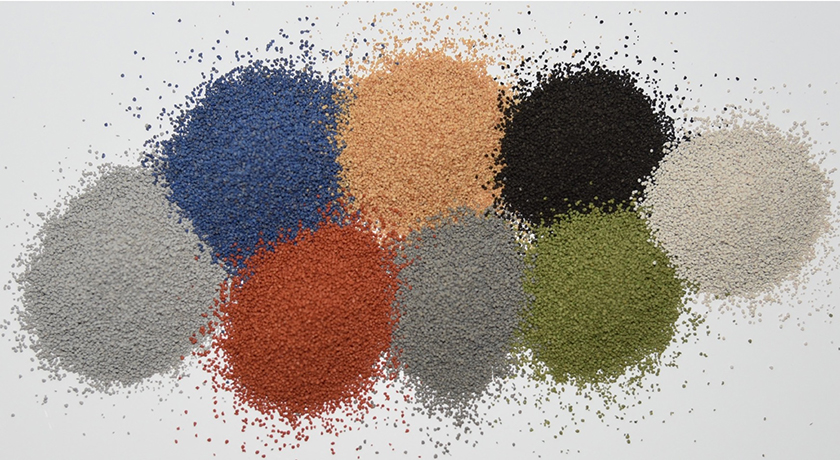More news
- PPG recognised for sustainability progress by FTSE4Good for sixth consecutive year
- Focus on industrial: Powering the energy industry during extreme heat
- Focus on powder coatings: The coatings industry’s transition to PFAS/PTFE-free solut...
- Birla Carbon Plants in USA, Canada, and Spain secure ISCC PLUS Certification
- Songwon awarded platinum level by EcoVadis for its sustainability achievements

Daniel Maisack, BioPowder, discusses the company’s use of olive stones as a raw material for the coatings industry
 As we all know, the climate is changing. At BioPowder, our mission is to provide formulators with raw materials and additives with an excellent functional and environmental profile. One word, which is in everybody’s mind, is sustainability. But what exactly does it mean for raw materials and additives? We think, both the carbon footprint and the environmental footprint are relevant indicators to look at. The former includes the emissions profile throughout the value chain of production and use while the latter looks at the effect on the food chain, renewable and/or by-product origin and biodegradability. Olive stones, the raw material of BioPowder’s functional powders, ticks all the boxes.
As we all know, the climate is changing. At BioPowder, our mission is to provide formulators with raw materials and additives with an excellent functional and environmental profile. One word, which is in everybody’s mind, is sustainability. But what exactly does it mean for raw materials and additives? We think, both the carbon footprint and the environmental footprint are relevant indicators to look at. The former includes the emissions profile throughout the value chain of production and use while the latter looks at the effect on the food chain, renewable and/or by-product origin and biodegradability. Olive stones, the raw material of BioPowder’s functional powders, ticks all the boxes.
Olive stones: upcycled bio-carbon
A circular raw material that has lately gained wider attention is the olive pit, a by-product of the olive oil mill. Olive oil manufacturing involves compressing the whole olive, which produces a solid residue of pulp, peel and fragmented pits. In the past, raw olive pits have mainly been used for combustion. In some countries, they are still considered as waste products and not yet part of any upcycling value chain.
Specialised machines are used to process the pomace in a moist state and olive pit fragments are separated from the pulp and shell through a centrifugation process. The fragments are then mechanically cleaned, dried and screened based on their particle sizes. Through this complex treatment process, BioPowder recovers light beige granules that are free of any dust/pulp and nearly odourless. The company further processes them into micronised powders, i.e. circular additives with desirable properties for modern coating formulations.
Olive stone powders mainly consist of lignin and cellulose, and the particle surface is characterised by OH-functionality. Interestingly, they are a source of bio-carbon (carbon content = 40-45%) due to the fact that the olive tree captures CO2 from the atmosphere. Emissions impacting the carbon footprint are mostly due to the energy consumption needed for micronisation. All in all, research has found that the olive processing ecosystem is CO2neutral, with olive stones being a renewable, non-food material with versatile fields of use.

Olive stone particles – 6 micron ranges
Functionality of natural (untreated) olive stone powder
Having covered sustainability and general composition, we can look more into the technical details of functional olive stone powder. Micronised olive stone powders are available in different particle size distributions and with different surface functionalisation treatments. Focusing on the natural (untreated) olive stone powder at first, it is a porous, lightweight filler with a natural hydroxy-functionalised surface with some inherent, residual moisture. All these properties can be advantageous to varying degrees, depending on the binders and/or application.
Application examples: lightweight paired with texture effects
This paragraph provides an overview of exemplary applications with olive stone powders as functional fillers:
- Matte, water-based, pigmented 2-component polyurethane topcoat: The high porosity of the powder raises the viscosity and brings some “body” in the topcoat formulation to have good application properties. In conventional systems, associative thickeners are often used to ensure the right application properties. To create the matte finish, a wax, a polymer-based matting filler, or a thermal-treated silica have conventionally been used. As those traditional solutions are generally carbon and/or energy-intensive, there is room for sustainable innovation with olive stone powder.
- Anti-slip topcoat, based on the above technology, with olive stone particles in the range of 300-600 microns: while the fine filler particles are bonded in the matrix, the coarser grains with sizes larger than the layer thickness produced a textured surface. The result is a topcoat with anti-slip properties. For this application, plastic particles or silica sand have conventionally been used. Olive stone particles have a medium hardness (3.5 on the Mohs scale), which makes them withstand low to medium mechanical loads. For higher resistance, silica sand, or even harder fillers like aluminium oxide (corundum) or silicon carbide can be added.
- Solvent-free epoxy-based binder to produce a “stone carpet” with olive stone granules in the particle size range of 2-6mm: For this application, untreated, natural olive stones add a nature-inspired look and a porous structure. For flooring systems with very high aesthetic requirements, pre-treated, coloured granules are recommended. Due to the even distribution of the dyes on the surface, the particles have a uniform colour, and the porosity is lower compared to the natural grade. With this special pre-treatment, less binder is needed for the application.
- Lightweight coatings: Olive stone powders have an inherent density of about 1.3 g/cm³. Compared to conventional fillers like silica sand, talcum, calcium carbonate etc. – all with ~ 2.7 g/cm³ – or a barium sulphate with a density of 4.4 g/cm³, olive stone powders are well suited to reduce a formulation’s overall weight. These are particularly relevant for the transportation industry, e.g. for railway or aerospace applications, where lightweight solutions can greatly reduce the demand for fossil energy.
READ MORE:
“The number one challenge for the coating industry today is decarbonisation”
Particle surface functionalisation to tackle formulation challenges
The characteristics of natural olive stone powders doubtlessly create opportunities for new bio-based coating formulations. In some instances, however, the lignocellulosic composition can give rise to certain challenges. One of them is the inherent residual moisture of the olive stone powder. If used in non-aqueous polyurethane systems, a common effect is the formation of CO2 bubbles in the coating layer due to reactivity with the isocyanate component. To suppress this type of reactivity, we have developed dehydrated and functionalised powders and particles. The trend towards isocyanate-free PU systems is also likely to create new opportunities for plant-based functional fillers.
Other testing focuses on the long-term stability of coating formulations featuring olive stone powder. Depending on the end use, different weathering or stress tests are applied over long periods to determine the impact of olive stone powder on the overall resistance. Existing literature discusses salt spray and water exposure, making the case for hydrophobicity treatments to limit water uptake and to ensure an intact surface.
In coloured systems like self-levellers or top coats, the aesthetics of the olive stone particles can play a fundamental role. Natural olive stone powder has a beige colour which might produce a darker and more brownish tone when incorporated into a binder system. For formulators wishing to create a filled and coloured system, we have developed pigmented and whitened particles. Aiming for the lowest impact on the system, different dyeing techniques need to be applied to different particle size ranges. Especially the lower particle size products, e.g. powders with 0-100 microns or lower, require innovative approaches and extensive testing.
Embracing olive stone powders as sustainable coating fillers extends beyond mere product benefits. It represents a commitment to environmental stewardship and collaborative innovation. Derived from olive oil production by-products, these powders showcase circularity and sustainability. Beyond functionality, their role is about fostering an open dialogue, encouraging research collaboration, and contributing to a paradigm shift towards eco-friendly solutions. At BioPowder, it’s not just about our product; it’s about catalysing a community-driven approach towards greener practices in the coatings industry.
For more information, visit www.bio-powder.com or email info@bio-powder.com.
Main image caption: Olea Colors – biodegradable colour particles







